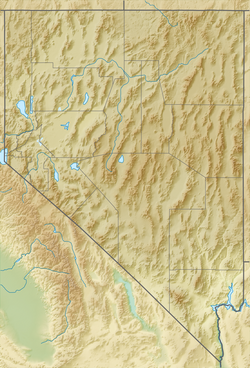
A | B | C | D | E | F | G | H | CH | I | J | K | L | M | N | O | P | Q | R | S | T | U | V | W | X | Y | Z | 0 | 1 | 2 | 3 | 4 | 5 | 6 | 7 | 8 | 9
Las Vegas | |
|---|---|
|
| |
| Etymology: from Spanish las vegas 'the meadows' | |
| Nicknames: | |
| Coordinates: 36°10′30″N 115°08′11″W / 36.17500°N 115.13639°W | |
| Country | United States |
| State | Nevada |
| County | Clark |
| Founded | May 15, 1905 |
| Incorporated | March 16, 1911 |
| Government | |
| • Type | Council–manager |
| • Mayor | Carolyn Goodman (I) |
| • Mayor Pro Tem | Brian Knudsen (D) |
| • City council | Members
|
| • City manager | Jorge Cervantes |
| Area | |
| • City | 141.91 sq mi (367.53 km2) |
| • Land | 141.85 sq mi (367.40 km2) |
| • Water | 0.05 sq mi (0.14 km2) |
| Elevation | 2,001 ft (610 m) |
| Population (2020) | |
| • City | 641,903 |
| • Rank | 75th in North America 25th in the United States 1st in Nevada |
| • Density | 4,525.16/sq mi (1,747.17/km2) |
| • Urban | 2,196,623 (US: 21st) |
| • Urban density | 5,046.3/sq mi (1,948.4/km2) |
| • Metro | 2,265,461 (US: 29th) |
| Demonym | Las Vegan |
| GDP | |
| • Las Vegas (MSA) | $160.7 billion (2022) |
| Time zone | UTC−08:00 (PST) |
| • Summer (DST) | UTC−07:00 (PDT) |
| ZIP Codes | 89044, 89054, 891xx |
| Area code | 702 & 725 |
| FIPS code | 32-40000 |
| GNIS feature ID | 847388 |
| Website | lasvegasnevada |
Las Vegas,[6] often known simply as Vegas, is the most populous city in the U.S. state of Nevada and the county seat of Clark County. The Las Vegas Valley metropolitan area is the largest within the greater Mojave Desert, and second-largest in the Southwestern United States.[7][8] Las Vegas is an internationally renowned major resort city, known primarily for its gambling, shopping, fine dining, entertainment, and nightlife, with most venues centered on downtown Las Vegas and more to the Las Vegas Strip just outside city limits. The Las Vegas Valley as a whole serves as the leading financial, commercial, and cultural center for Nevada. According to the United States Census Bureau, the city had 641,903 residents in 2020,[9] with a metropolitan population of 2,227,053,[10] making it the 25th-most populous city in the United States.
The city bills itself as the Entertainment Capital of the World, and is famous for its luxurious and extremely large casino-hotels. With over 2.9 million visitors as of 2019, Las Vegas is the sixth-most visited city in the U.S., after New York City, Miami, Los Angeles, Orlando, and San Francisco.[11] It is a top-three destination in the U.S. for business conventions and a global leader in the hospitality industry, claiming more AAA Five Diamond hotels than any other city in the world.[12][13][14] Las Vegas annually ranks as one of the world's most visited tourist destinations.[15][16] The city's tolerance for numerous forms of adult entertainment had earned it the nickname "Sin City",[17] and has made Las Vegas a popular setting for literature, films, television programs, and music videos.
Las Vegas was settled in 1905 and officially incorporated in 1911. At the close of the 20th century, it was the most populated North American city founded within that century (a similar distinction was earned by Chicago in the 19th century). Population growth has accelerated since the 1960s and into the 21st century, and between 1990 and 2000 the population nearly doubled, increasing by 85.2%. As with most major metropolitan areas, the name of the primary city ("Las Vegas" in this case) is often used to describe areas beyond official city limits. In the case of Las Vegas, this especially applies to the areas on and near the Strip, which are actually in the unincorporated communities of Paradise and Winchester.[18][19] Over time and influenced by climate change, droughts in Southern Nevada, already one of the driest regions in the United States, have been increasing in frequency and severity,[20] putting a further strain on Las Vegas's water security.
Toponymy
The area was named Las Vegas, which is Spanish for "the meadows", as it featured abundant wild grasses, as well as the desert spring waters needed by westward travelers.[21] The city is often simply called "Vegas".[22][23][24][25][26]
History
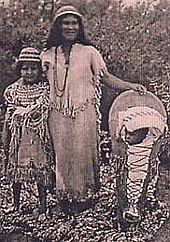
Nomadic Paleo-Indians traveled to the Las Vegas area 10,000 years ago, leaving behind petroglyphs. Ancient Puebloan and Paiute tribes followed at least 2,000 years ago.[27]
A young Mexican scout named Rafael Rivera is credited as the first non-Native American to encounter the valley, in 1829.[28] Trader Antonio Armijo led a 60-man party along the Spanish Trail to Los Angeles, California, in 1829.[29][30] In 1844, John C. Frémont arrived, and his writings helped lure pioneers to the area. Downtown Las Vegas's Fremont Street is named after him.
Eleven years later, members of the Church of Jesus Christ of Latter-day Saints chose Las Vegas as the site to build a fort halfway between Salt Lake City and Los Angeles, where they would travel to gather supplies. The fort was abandoned several years afterward. The remainder of this Old Mormon Fort can still be seen at the intersection of Las Vegas Boulevard and Washington Avenue.
Las Vegas was founded as a city in 1905, when 110 acres (45 ha) of land adjacent to the Union Pacific Railroad tracks were auctioned in what would become the downtown area. In 1911, Las Vegas was incorporated as a city.[31]
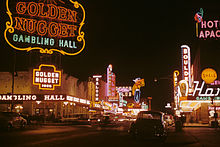
1931 was a pivotal year for Las Vegas. At that time, Nevada legalized casino gambling and reduced residency requirements for divorce to six weeks. This year also witnessed the beginning of construction on nearby Hoover Dam. The influx of construction workers and their families helped Las Vegas avoid economic calamity during the Great Depression. The construction work was completed in 1935.
In late 1941, Las Vegas Army Airfield was established. Renamed Nellis Air Force Base in 1950, it is now home to the United States Air Force Thunderbirds aerobatic team.[32]
Following World War II, lavishly decorated hotels, gambling casinos, and big-name entertainment became synonymous with Las Vegas.

In 1951, nuclear weapons testing began at the Nevada Test Site, 65 miles (105 km) northwest of Las Vegas. During this time, the city was nicknamed the "Atomic City". Residents and visitors were able to witness the mushroom clouds (and were exposed to the fallout) until 1963 when the Partial Nuclear Test Ban Treaty required that nuclear tests be moved underground.[33]
In 1955, the Moulin Rouge Hotel opened and became the first racially integrated casino-hotel in Las Vegas.
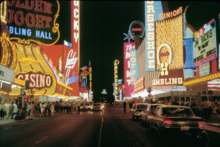
During the 1960s, corporations and business tycoons such as Howard Hughes were building and buying hotel-casino properties. Gambling was referred to as "gaming", which transitioned it into a legitimate business. Learning from Las Vegas, published during this era, asked architects to take inspiration from the city's highly decorated buildings, helping to start the postmodern architecture movement.
In 1995, the Fremont Street Experience opened in Las Vegas's downtown area. This canopied five-block area features 12.5 million LED lights and 550,000 watts of sound from dusk until midnight during shows held at the top of each hour.
Due to the realization of many revitalization efforts, 2012 was dubbed "The Year of Downtown". Projects worth hundreds of millions of dollars made their debut at this time, including the Smith Center for the Performing Arts, the DISCOVERY Children's Museum, the Mob Museum, the Neon Museum, a new City Hall complex, and renovations for a new Zappos.com corporate headquarters in the old City Hall building.[21][34]
Geography

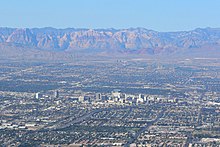
Las Vegas is the county seat of Clark County, in a basin on the floor of the Mojave Desert,[35] and is surrounded by mountain ranges. Much of the landscape is rocky and arid, with desert vegetation and wildlife. It can be subjected to torrential flash floods, although much has been done to mitigate the effects of flash floods through improved drainage systems.[36]
The city's elevation is approximately 2,030 ft (620 m) above sea level, though the surrounding peaks reach elevations of over 10,000 feet (3,000 m) and act as barriers to the strong flow of moisture from the surrounding area. According to the United States Census Bureau, the city has an area of 135.86 sq mi (351.9 km2), of which 135.81 sq mi (351.7 km2) is land and 0.05 sq mi (0.13 km2) (0.03%) is water.
After Alaska and California, Nevada is the third most seismically active state in the U.S. It has been estimated by the United States Geological Survey (USGS) that over the next 50 years, there is a 10–20% chance of an M6.0 or greater earthquake occurring within 50 km (31 mi) of Las Vegas.[37]
Within the city are many lawns, trees, and other greenery. Due to water resource issues, there has been a movement to encourage xeriscapes. Another part of conservation efforts is scheduled watering days for residential landscaping. A U.S. Environmental Protection Agency grant in 2008 funded a program that analyzed and forecast growth and environmental effects through 2019.
Climate
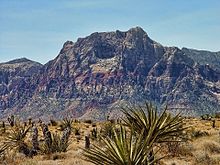
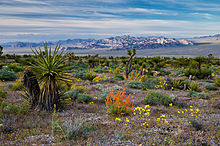
Las Vegas has a subtropical hot desert climate (Köppen climate classification: BWh), typical of the Mojave Desert in which it lies. This climate is typified by long, extremely hot summers; warm transitional seasons; and short winters with mild days and cool nights. There is abundant sunshine throughout the year, with an average of 310 sunny days and bright sunshine during 86% of all daylight hours.[38][39] Rainfall is scarce, with an average of 4.2 in (110 mm) dispersed between roughly 26 total rainy days per year.[40] Las Vegas is among the sunniest, driest, and least humid locations in North America, with exceptionally low dew points and humidity that sometimes remains below 10%.[41]
The summer months of June through September are extremely hot, though moderated by the low humidity levels. July is the hottest month, with an average daytime high of 104.5 °F (40.3 °C). On average, 137 days per year reach or exceed 90 °F (32 °C), of which 78 days reach 100 °F (38 °C) and 10 days reach 110 °F (43 °C). During the peak intensity of summer, overnight lows frequently remain above 80 °F (27 °C), and occasionally above 85 °F (29 °C).[38]
While most summer days are consistently hot, dry, and cloudless, the North American Monsoon sporadically interrupts this pattern and brings more cloud cover, thunderstorms, lightning, increased humidity, and brief spells of heavy rain. Potential monsoons affect Las Vegas between July and August. Summer in Las Vegas is marked by significant diurnal temperature variation. While less extreme than other parts of the state, nighttime lows in Las Vegas are often 30 °F (16.7 °C) or more lower than daytime highs.[42] The average hottest night of the year is 90 °F (32 °C). The all-time record is at 95 °F (35 °C).[38]
Las Vegas winters are short and generally very mild, with chilly (but rarely cold) daytime temperatures. Sunshine is abundant in all seasons. December is both the year's coolest and cloudiest month, with an average daytime high of 56.9 °F (13.8 °C) and sunshine occurring during 78% of its daylight hours. Winter evenings are defined by clear skies and swift drops in temperature after sunset, with overnight minima averaging around 40 °F (4.4 °C) in December and January. Owing to its elevation that ranges from 2,000 to 3,000 feet (610 to 910 m), Las Vegas experiences markedly cooler winters than other areas of the Mojave Desert and the adjacent Sonoran Desert that are closer to sea level. The city records freezing temperatures an average of 10 nights per winter. It is exceptionally rare for temperatures to reach or fall below 25 °F (−4 °C).[38]

Most of the annual precipitation falls during the winter. February, the wettest month, averages only four days of measurable rain. The mountains immediately surrounding the Las Vegas Valley accumulate snow every winter, but significant accumulation within the city is rare, although moderate accumulations occur every few years. The most recent accumulations occurred on February 18, 2019, when parts of the city received about 1 to 2 inches (2.5 to 5.1 cm) of snow[43] and on February 20 when the city received almost 0.5 inches (1.3 cm).[44] Other recent significant snow accumulations occurred on December 25, 2015, and December 17, 2008.[45] Unofficially, Las Vegas's largest snowfall on record was the 12 inches (30 cm) that fell in 1909.[46] In recent times, ice days have not occurred, although 29 °F (−2 °C) was measured in 1963.[38] On average the coldest day is 44 °F (7 °C).[38]
117 °F (47 °C) is the highest temperature officially observed for Las Vegas, as measured at Harry Reid International Airport on July 10, 2021, the last of five occasions.[38] The lowest temperature was 8 °F (−13 °C), recorded on two days: January 25, 1937, and January 13, 1963.[38] The highest temperature ever measured within the city of Las Vegas was 118 °F (48 °C) on July 26, 1931.[47] The official record hot daily minimum is 95 °F (35 °C) on July 19, 2005, and July 1, 2013. The official record cold daily maximum is 28 °F (−2 °C) on January 8 and 21, 1937.[38]
Due to concerns about climate change in the wake of a 2002 drought, daily water consumption has been reduced from 314 US gallons (1,190 L) per resident in 2003 to around 205 US gallons (780 L) in 2015.[48]
| Climate data for Harry Reid International Airport (Paradise, Nevada), 1991–2020 normals,[a] extremes 1937–present | |||||||||||||
|---|---|---|---|---|---|---|---|---|---|---|---|---|---|
| Month | Jan | Feb | Mar | Apr | May | Jun | Jul | Aug | Sep | Oct | Nov | Dec | Year |
| Record high °F (°C) | 77 (25) |
87 (31) |
92 (33) |
99 (37) |
109 (43) |
117 (47) |
117 (47) |
116 (47) |
114 (46) |
103 (39) |
87 (31) |
78 (26) |
117 (47) |
| Mean maximum °F (°C) | 68.7 (20.4) |
74.2 (23.4) |
84.3 (29.1) |
93.6 (34.2) |
101.8 (38.8) |
110.1 (43.4) |
112.9 (44.9) |
110.3 (43.5) |
105.0 (40.6) |
94.6 (34.8) |
80.5 (26.9) |
67.9 (19.9) |
113.6 (45.3) |
| Mean daily maximum °F (°C) | 58.5 (14.7) |
62.9 (17.2) |
71.1 (21.7) |
78.5 (25.8) |
88.5 (31.4) |
99.4 (37.4) |
104.5 (40.3) |
102.8 (39.3) |
94.9 (34.9) |
81.2 (27.3) |
67.1 (19.5) |
56.9 (13.8) |
80.5 (26.9) |
| Daily mean °F (°C) | 49.5 (9.7) |
53.5 (11.9) |
60.8 (16.0) |
67.7 (19.8) |
77.3 (25.2) |
87.6 (30.9) |
93.2 (34.0) |
91.7 (33.2) |
83.6 (28.7) |
70.4 (21.3) |
57.2 (14.0) |
48.2 (9.0) |
70.1 (21.2) |
| Mean daily minimum °F (°C) | 40.5 (4.7) |
44.1 (6.7) |
50.5 (10.3) |
56.9 (13.8) |
66.1 (18.9) |
75.8 (24.3) |
82.0 (27.8) |
80.6 (27.0) |
72.4 (22.4) |
59.6 (15.3) |
47.3 (8.5) |
39.6 (4.2) |
59.6 (15.3) |
| Mean minimum °F (°C) | 29.8 (−1.2) |
32.9 (0.5) |
38.7 (3.7) |
45.2 (7.3) |
52.8 (11.6) |
62.2 (16.8) |
72.9 (22.7) |
70.8 (21.6) |
60.8 (16.0) |
47.4 (8.6) |
35.2 (1.8) |
29.0 (−1.7) |
27.4 (−2.6) |
| Record low °F (°C) | 8 (−13) |
16 (−9) |
19 (−7) |
31 (−1) |
38 (3) |
48 (9) |
56 (13) |
54 (12) |
43 (6) |
26 (−3) |
15 (−9) |
11 (−12) |
8 (−13) |
| Average precipitation inches (mm) | 0.56 (14) |
0.80 (20) |
0.42 (11) |
0.20 (5.1) |
0.07 (1.8) |
0.04 (1.0) |
0.38 (9.7) |
0.32 (8.1) |
0.32 (8.1) |
0.32 (8.1) |
0.30 (7.6) |
0.45 (11) |
4.18 (106) |
| Average snowfall inches (cm) | 0.0 (0.0) |
0.0 (0.0) |
0.0 (0.0) |
0.0 (0.0) |
0.0 (0.0) |
0.0 (0.0) |
0.0 (0.0) |
0.0 (0.0) |
0.0 (0.0) |
0.0 (0.0) |
0.0 (0.0) |
0.2 (0.51) |
0.2 (0.51) |
| Average precipitation days (≥ 0.01 in) | 3.1 | 4.1 | 2.8 | 1.6 | 1.1 | 0.4 | 2.5 | 2.2 | 1.8 | 1.7 | 1.5 | 3.0 | 25.8 |
| Average snowy days (≥ 0.1 in) | 0.0 | 0.1 | 0.0 | 0.0 | 0.0 | 0.0 | 0.0 | 0.0 | 0.0 | 0.0 | 0.0 | 0.1 | 0.2 |
| Average relative humidity (%) | 45.1 | 39.6 | 33.1 | 25.0 | 21.3 | 16.5 | 21.1 | 25.6
Zdroj:https://en.wikipedia.org?pojem=Las_Vegas,_Nevada Text je dostupný za podmienok Creative Commons Attribution/Share-Alike License 3.0 Unported; prípadne za ďalších podmienok. Podrobnejšie informácie nájdete na stránke Podmienky použitia.
Analytika
Antropológia Aplikované vedy Bibliometria Dejiny vedy Encyklopédie Filozofia vedy Forenzné vedy Humanitné vedy Knižničná veda Kryogenika Kryptológia Kulturológia Literárna veda Medzidisciplinárne oblasti Metódy kvantitatívnej analýzy Metavedy Metodika Text je dostupný za podmienok Creative
Commons Attribution/Share-Alike License 3.0 Unported; prípadne za ďalších
podmienok. www.astronomia.sk | www.biologia.sk | www.botanika.sk | www.dejiny.sk | www.economy.sk | www.elektrotechnika.sk | www.estetika.sk | www.farmakologia.sk | www.filozofia.sk | Fyzika | www.futurologia.sk | www.genetika.sk | www.chemia.sk | www.lingvistika.sk | www.politologia.sk | www.psychologia.sk | www.sexuologia.sk | www.sociologia.sk | www.veda.sk I www.zoologia.sk | |||||













